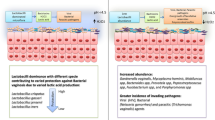Abstract
Objective
This study aimed to investigate the influence of endocervical pH on vaginal pH, and also the changes in these pH values following hysterectomy and cold-knife conization. Vaginal pH is important for maintaining the equilibrium of the vaginal microflora.
Patients and methods
Two groups of women were studied: the first (n = 20, median age 45, range 33–50 years-old), before and after hysterectomy (without ovariectomy) for myomatosis; the second group (n = 18, median age 38.5, range 37–65 years-old), before and after cold-knife conization for cervical intraepithelial neoplasia (CIN) grade II or III. Four samples (before and 90 days after surgery) were collected from the women by means of swabs: (1) anterior vaginal fornix, (2) posterior vaginal fornix, (3) posterior wall of lower vagina, and (4) endocervix (except in cases after hysterectomy). The pH was measured using a digital pHmeter (Sentron).
Results
We observed that endocervical pH was less acidic than were all the vaginal locations measured, before both surgeries. After both surgeries, all vaginal pH measurements were higher, but without reaching statistical significance. Endocervical pH correlated with vaginal pH.
Conclusions
We concluded that recent hysterectomy does not alter vaginal pH and that vaginal and endocervical pH values are related.
Similar content being viewed by others
References
Adad SJ, Lima VR, Sawan ZTE, Silva MLG, Souza MAH, Saldanha JC, Falco VAA, Cunha AH, Murta EFC (2001) Frequency of Trichomonas vaginalis, Candida sp, and Gardnerella vaginalis in cervical–vaginal smears in four different decades. São Paulo Med J 119:200–205
Garcia-Closas M, Herrero R, Bratti C, Hildesheim A, Sherman ME, Morera LA, Schiffman M (1999) Epidemiologic determinants of vaginal pH. Am J Obstet Gynecol 180:1060–1065
Hart G (1993) Factors associated with trichomoniasis, candidasis and bacterial vaginosis. Int J STD AIDS 4:21–25
Kent HL (1991) Epidemiology of vaginitis. Am J Obstet Gynecol 165:1168–1176
Liu LX (1986) Human cervical mucus. Shengzhi Yu Biyun 6:3–7
Mirza NB, Nsanze H, D´Costa LJ, Piot P (1983) Microbiology of vaginal discharge in Nairobi, Kenya. Br J Vener Dis 59:186–188
Murta EFC, Filho ACA, Barcelos ACM (2005) Relation between vaginal and endocervical pH in pre and post-menopausal women. Arch Gynecol Obstet 272:211–213
Murta EFC, Silva AO, Silva EAC, Adad SJ (2005) Frequency of infectious agents for vaginitis in non- and hysterectomized women. Arch Gynecol Obstet 273:152–156
Murta EF, Souza MA, Araújo Junior E, Adad SJ (2000) Incidence of Gardnerella vaginalis, Candida sp and human papilloma virus in cytological smears. Sao Paulo Med J 118:105–108
Oyarzún EE, Poblete AL, Montiel FA, Gutiérrez PH (1996) Vaginosis bacteriana: diagnostico y prevalencia. Rev Chil Obstet Ginecol 61:28–33
Silva CS, Terra APS, Adad SJ, Barcelos ACM, Souza MAH, Murta EFC (2004) Increased frequency of bacterial vaginosis and Clamydia trachomatis in pregnancy women with HPV infection. Gynecol Obstet Invest 58:189–193
Acknowledgments
We thank CNPq and FAPEMIG for financial support.
Author information
Authors and Affiliations
Corresponding author
Rights and permissions
About this article
Cite this article
Murta, E.F.C., Perfeito, P.B., Oliveira, T.M. et al. Relation between vaginal and endocervical pH in patients undergoing cold-knife conization and hysterectomy. Arch Gynecol Obstet 277, 43–46 (2008). https://doi.org/10.1007/s00404-007-0420-7
Received:
Accepted:
Published:
Issue Date:
DOI: https://doi.org/10.1007/s00404-007-0420-7




